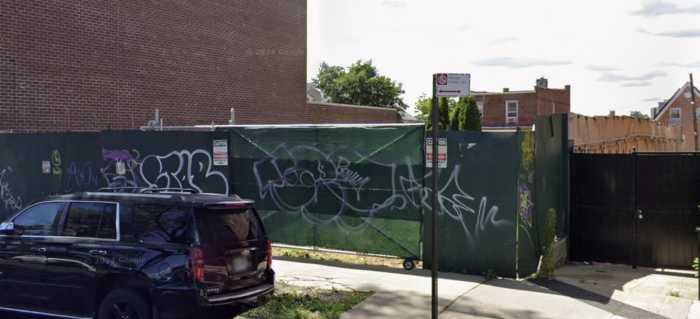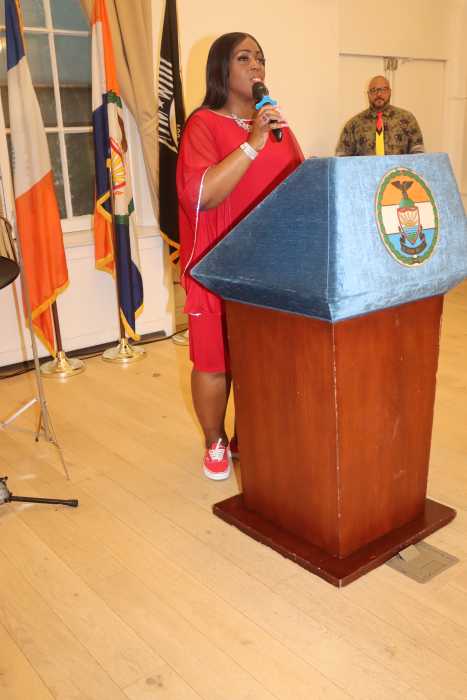Alli Mauzey and Kevin Pairseau in Arnold Weinstein, John Wulp, and Sam Davis' “Red Eye of Love.” | CAROL ROSEGG
You don’t have to be versed in the idiosyncratic and deconstructive whimsy that informed the early Off-Off Broadway movement to fall for “Red Eye of Love.” It can be enjoyed pretty much on its own as a satire on the level of “Dames at Sea” or “The Boyfriend.”
The 1961 play by Arnold Weinstein was a trenchant political piece about art, commerce, and love that employed a superficial tone to deliver a more caustic message. It calls to mind the work of other playwrights of the period, notably Robert Patrick, Charles Dizenzo, and even early Terrence McNally and Edward Albee.
Adapted as a musical with a book by Weinstein and John Wulp and music by Sam Davis, it is structured as a dichotomy between the economical and the oversized and absurdist. The plot’s central element concerns the conflict among the owner of a skyscraper-sized department store exclusively selling meat, a poor man who wants to live for art, and the woman for whose love they are competing.
Two exceptional shows examine creators, creations, and survival
The opposition of art and commerce and of marriage for love and marriage for wealth might initially seem hackneyed, but that’s the point. “Red Eye of Love” is cleverly self-consciousness in lampooning these theatrical tropes, suggesting that they may be as corrupt as the world the characters inhabit. The plot, which makes huge jumps in time over about 40 years, juxtaposes dark messages about a debased culture and self-serving people with gauzy musical pastiche. The result is chilling, fascinating, and delightful.
Davis’ bright and tuneful score has many wonderful and appropriately disconcerting surprises. There are tap-dancing cows, a man who wants to create the perfect doll that can’t die and, of course, hymns to meat as both a commodity and a basis of wealth. The choreography by Lainie Sakakura and Alex Sanchez is, like the score, a wonderful mash-up of styles, beautifully tailored to the stage and the company.
Kevin Pariseau plays the meat mogul O. O. Martinas with a great sense of bombast. As his rival, the poet Wilmer Flange, Josh Grisetti is spectacular. He has a magnificent voice, terrific range, and is completely at home in the abstracted style. He looks like a kind of poetic everyman, and his resemblance to Harold Lloyd, the 1920s comedian from silent movies, can’t be accidental.
Alli Mauzey is equally wonderful as Selma Chargesse, the indecisive woman at the heart of the story. Mauzey has a glorious soprano voice and a facility with the different styles of singing required of her. These three are supported by a small but sensational ensemble.
Under the adroit direction of Ted Sperling, the styles and symbols are wonderfully balanced. It’s not easy to have frothy entertainment laid on a core of dark, borderline cynical social criticism, but whether appreciated on its own or in the context of an underappreciated period that used conventions to thwart convention, “The Red Eye of Love” is a clear-eyed hit.
Sherman Howard and Stacy Ross in Lauren Gunderson’s “Bauer.” | CAROL ROSEGG
The human cost of the conflict between pure art and powerful capitalism is at the heart of another new play based on a true story — the quietly exciting “Bauer” now at 59E59 Theaters. Artist Rudolf Bauer was jailed by the Nazis for his “degenerate art,” and later, after he was rescued, Solomon Guggenheim designed his New York museum to showcase Bauer’s art. But when Bauer learned that in accepting the cash and accolades of Guggenheim he had signed away the rights to his work and all future “product,” he retreated to his home and refused to paint. The play begins as his former lover and agent Hilla von Rebay arrives to try to get him to paint again. Hilla and Bauer’s wife, Louise, initially clash, only to become allies in trying to get him to return to life.
This deceptively simple story has been given vibrant life by playwright Lauren Gunderson. It is not so much the story of an artist but a psychological drama about ambition, survival, love, and sacrifice. The characters battle for power, and in a taut 90 minutes, the power and the alliances between the characters shift so often that the audience remains constantly on the edge of their seats. As much as the question of whether Bauer will ever pick up a brush again, the play is about how we all struggle, learn to deal with life’s reversals and our own bad choices, and find a way to go on.
Under Bill English’s direction, the finely etched characters are consistently compelling. Hilla is as desperate to save her own reputation as she is to get Bauer to paint. Louise is driven by her love for Bauer, going against her better judgment to force the issue. Bauer struggles to find himself again, to recapture what he gave away or lost. We understand from the start how much is at stake for each of these characters, and that’s what makes this particularly riveting theater.
That… and the extraordinary cast, who offer some of the best acting to be seen in New York right now. Sherman Howard is a strong and focused Bauer, trying to cope with the rage and disappointment that is killing him physically and spiritually. Susi Damilano inhabits Louise with a ferocity and love for Bauer that blazes through her performance. Funny, manipulative, and at the same time vulnerable, she is every bit a match for Hilla, even if Hilla underestimates her at first. As Hilla, Stacy Ross gives a performance that is both larger than life and richly nuanced. The struggle between her love for Bauer and her self-interest and ego makes her a fascinating character study, and Ross fills every moment.
Creating art imposes order on an inherently disordered world. In “Bauer,” that process is a poignant metaphor, and how we do it — and whether we can — is an open question for each of us. Out of this tension and uncertainty we get truly exciting drama.
RED EYE OF LOVE Dicapo Opera Theatre | 184 E. 76th St. | Through Sep. 28: Wed.-Sat. at 8 p.m.; Wed., Sat.-Sun. at 3 p.m. | $35-$75 at smartix.com or 212-868-4444 | Two hrs.
BAUER | 59E59 Theaters, 59 E. 59th St. | Through Oct. 12: Tue.-Thu. at 7 p.m.; Fri.-Sat. at 8 p.m.: Sat. at 2 p.m.; Sun. at 3 p.m. | $70 at ticketcentral.com or 212-279-4200 | 90 min.















